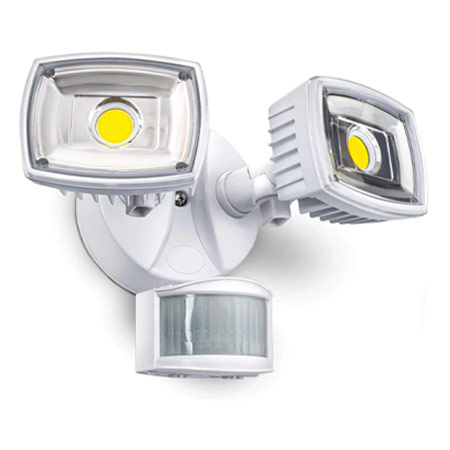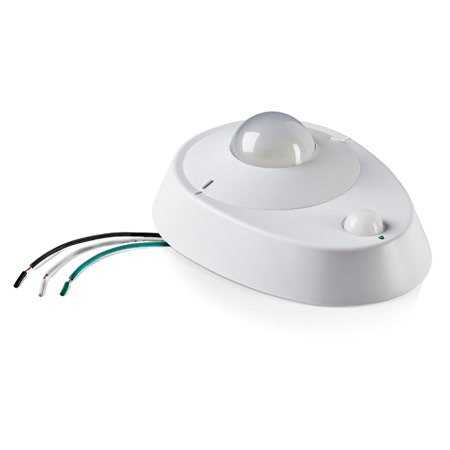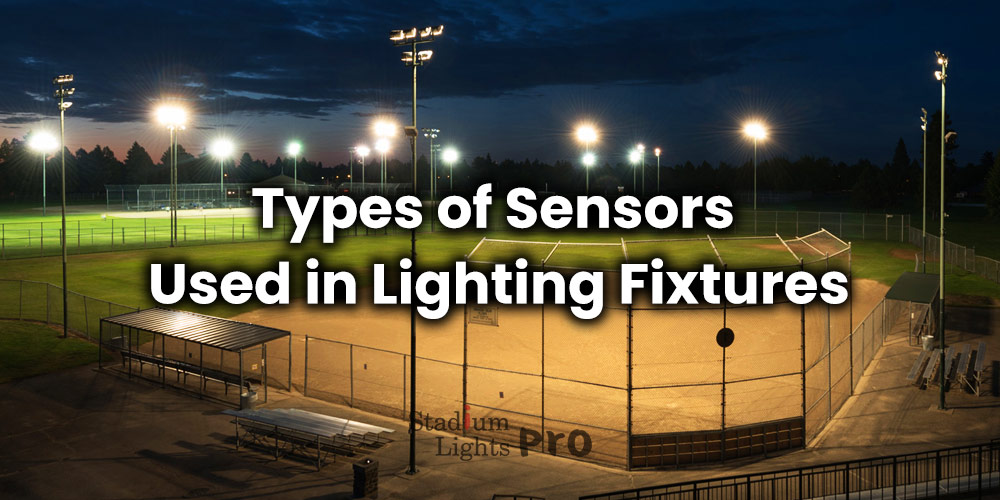Sensors on lighting are devices that are used to detect certain conditions or stimuli in the environment, and to trigger the lighting fixture to turn on or off, or to adjust its intensity or color, based on the sensed input. Sensors can be used to control lighting in a variety of settings, including homes, offices, public spaces, and industrial environments.
Table of Contents
ToggleMotion sensors
 Motion sensors are devices that are used to detect movement in the area around a lighting fixture. They are commonly used in outdoor lighting fixtures, such as porch lights or floodlights, as well as in indoor fixtures, such as overhead lights or under-cabinet lights.
Motion sensors are devices that are used to detect movement in the area around a lighting fixture. They are commonly used in outdoor lighting fixtures, such as porch lights or floodlights, as well as in indoor fixtures, such as overhead lights or under-cabinet lights.
When a motion sensor detects movement, it sends a signal to the lighting fixture to turn on. The lights will typically stay on for a set period of time, after which they will automatically turn off again. This helps to conserve energy by ensuring that the lights are only on when they are needed.
Motion sensors can be set to detect movement over a certain range or distance, and can also be set to ignore movement from certain sources, such as small animals or vehicles. Some motion sensors can also detect the difference between movement from people and movement from other sources, allowing them to turn the lights on or off accordingly.
Occupancy sensors
 Occupancy sensors are devices that are used to detect whether a room or space is occupied or not. They are commonly used in lighting fixtures, as well as in heating, ventilation, and air conditioning (HVAC) systems.
Occupancy sensors are devices that are used to detect whether a room or space is occupied or not. They are commonly used in lighting fixtures, as well as in heating, ventilation, and air conditioning (HVAC) systems.
When an occupancy sensor detects that a room is unoccupied, it will send a signal to the lighting fixture or HVAC system to turn off or reduce power. This helps to conserve energy by ensuring that lighting and other systems are only on when they are needed.
Occupancy sensors can be set to detect movement over a certain range or distance, and can also be set to ignore movement from certain sources, such as small animals or vehicles. Some occupancy sensors can also detect the difference between movement from people and movement from other sources, allowing them to turn the lights on or off accordingly.
Light level sensors
Light level sensors, also known as lux meters or photometers, are devices that measure the amount of ambient light in an area. They are commonly used in lighting fixtures, as well as in other applications such as cameras, smartphones, and wearable devices.
These sensors work by measuring the intensity of light in a specific wavelength range, typically around 550 nanometers (nm), which is the peak sensitivity of the human eye. The measurement is expressed in units of illuminance, also known as lux.
In lighting fixtures, light level sensors can be used to adjust the intensity or color of the lights based on the ambient light level. For example, a light level sensor could be used to automatically dim the lights in a room during the daytime, when there is plenty of natural light, and to increase the light level in the evening, when the ambient light level is lower.
Timer sensors
Timer sensors are devices that are used to control the timing of lighting fixtures or other systems based on a pre-set schedule. They are commonly used in residential, commercial, and industrial settings to conserve energy and automate certain tasks.
Timer sensors can be set to turn the lights on or off at specific times of the day, or to trigger other events based on a schedule. For example, a timer sensor could be used to turn the lights on in a room at 7:00 AM and turn them off at 10:00 PM every day, or to turn the lights on in a storefront at 8:00 AM and turn them off at 6:00 PM on weekdays, but keep them on until 9:00 PM on weekends.
Remote control sensors
Remote control sensors are devices that allow you to control a lighting fixture or other system remotely, using a remote control or a smartphone app. They are commonly used in residential, commercial, and industrial settings to provide convenient and flexible control over lighting and other systems.
Remote control sensors work by receiving signals from a remote control or a smartphone app, and transmitting those signals to the lighting fixture or other system. The remote control or app can be used to turn the lights on or off, adjust the intensity or color of the lights, or trigger other events, such as activating an alarm or changing the temperature of a thermostat.
The sensors can be used in a variety of settings, including homes, offices, public spaces, and industrial environments. They can be especially useful in settings where it is inconvenient or impractical to control the lighting or other systems manually, such as in high or hard-to-reach places, or in areas where it is not safe or practical to have a physical switch or control panel.
Smart sensors
Smart sensors are sensors that are connected to a smart home system, allowing you to control the lighting and other systems using a central hub or a smartphone app. Smart sensors can be used to detect a wide range of conditions or stimuli, such as movement, ambient light levels, temperature, humidity, and more.
These sensors can be placed throughout your home, and are connected to a central hub that communicates with the sensors and controls the lighting and other systems. You can use a smartphone app or a web-based interface to access and control the system from anywhere.
It can be used to automate a wide range of tasks, such as turning the lights on or off when you enter or leave a room, adjusting the temperature of your thermostat based on the weather or your schedule, or triggering an alarm if there is a leak or other emergency.
Solar sensors
Solar sensors, also known as photovoltaic cells or solar panels, are devices that use sunlight to generate electricity. They are commonly used in lighting fixtures and other systems to provide a renewable and energy-efficient source of power.
They work by converting sunlight into electricity using photovoltaic cells, which are made of semiconductor materials such as silicon. When sunlight hits the cells, it excites the electrons in the semiconductor material, causing them to flow, generating an electric current.
In lighting fixtures, solar sensors can be used to power the lights directly, or to charge a battery or other energy storage device, which can then be used to power the lights when the sun is not shining. Solar sensors can also be used in other systems, such as water pumps, fans, and alarms, to provide a renewable and energy-efficient source of power.
Temperature sensors
Temperature sensors are devices that are used to measure the temperature in a specific location or area. They are commonly used in lighting fixtures, as well as in other applications such as heating, ventilation, and air conditioning (HVAC) systems, appliances, and industrial processes.
These sensors work by detecting changes in the temperature of the environment and converting that information into an electrical signal that can be measured and interpreted by a device or system. The measurement is typically expressed in degrees Celsius or Fahrenheit.
Besides, they can be used to adjust the lighting or other systems based on the temperature in the area. For example, a temperature sensor could be used to turn on a fan or air conditioner when the temperature in a room gets too hot, or to turn off the heating when the temperature gets too cold.
Humidity sensors
Humidity sensors are devices that are used to measure the humidity in a specific location or area. They are commonly used in lighting fixtures, as well as in other applications such as heating, ventilation, and air conditioning (HVAC) systems, appliances, and industrial processes.
They work by detecting changes in the humidity of the environment and converting that information into an electrical signal that can be measured and interpreted by a device or system. The measurement is typically expressed as a percentage of relative humidity, which is the amount of moisture in the air compared to the maximum amount that the air can hold at a given temperature.
In lighting fixtures, these sensors can be used to adjust the lighting or other systems based on the humidity in the area. For example, a humidity sensor could be used to turn on a dehumidifier or humidifier when the humidity in a room gets too high or too low, or to adjust the ventilation based on the humidity level.
Pressure sensors
Pressure sensors are devices that are used to measure the pressure of a gas or a liquid in a specific location or area. They are commonly used in lighting fixtures, as well as in other applications such as heating, ventilation, and air conditioning (HVAC) systems, appliances, and industrial processes.
These sensors work by detecting changes in the pressure of the gas or liquid and converting that information into an electrical signal that can be measured and interpreted by a device or system. The measurement is typically expressed in units of pressure, such as pounds per square inch (psi) or pascals (Pa).
A pressure sensor could be used to turn on a fan or air conditioner when the pressure in a room gets too high or too low, or to adjust the ventilation based on the pressure level.
Sound sensors
Sound sensors, also known as microphones or audio sensors, are devices that are used to detect sound in a specific location or area. They are commonly used in lighting fixtures, as well as in other applications such as alarms, security systems, and audio equipment.
Sound sensors work by converting sound waves into an electrical signal that can be measured and interpreted by a device or system. The measurement is typically expressed in units of sound pressure level, such as decibels (dB).
A sound sensor could be used to turn on a fan or air conditioner when the sound level in a room gets too loud, or to adjust the lighting based on the sound level.
Vibration sensors
Vibration sensors, also known as accelerometers or motion sensors, are devices that are used to detect vibrations in a specific location or area. They are commonly used in lighting fixtures, as well as in other applications such as alarms, security systems, and industrial equipment.
They work by detecting changes in the acceleration or movement of an object, and converting that information into an electrical signal that can be measured and interpreted by a device or system. The measurement is typically expressed in units of acceleration, such as meters per second squared (m/s^2) or g-forces.
A vibration sensor could be used to turn on a fan or air conditioner when the vibrations in a room get too strong, or to adjust the lighting based on the vibrations.
Conclusion
The specific type of sensor used will depend on the specific needs and requirements of the application. Sensors can be used to control lighting in a variety of settings, including homes, offices, public spaces, and industrial environments, and can help to conserve energy and improve the convenience, security, and comfort of the space.
If you are considering upgrading your lighting or installing new lighting in your home or business, we encourage you to contact us for advice. Our team of lighting experts can help you choose the best lighting fixtures and sensors for your specific needs and budget, and can provide guidance on the installation and maintenance of your lighting system.
We offer a wide range of lighting products and services, including LED lighting, smart lighting, outdoor lighting, commercial lighting, and more. We are committed to helping our customers find the best lighting solutions to meet their needs, and to providing exceptional customer service.
If you would like to learn more about our lighting products and services, or if you have any questions or concerns, please don’t hesitate to contact us. We would be happy to assist you in any way we can.

